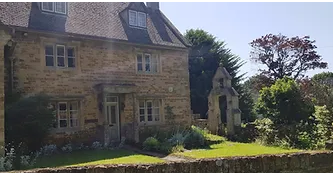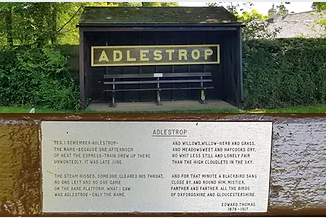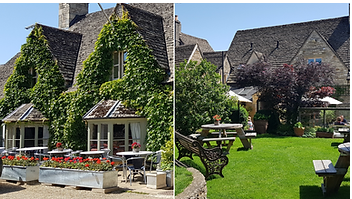

Full-day country walks in
SE England and beyond
Kingham circular
Distance: 10.7 miles.
Time without long breaks: Apx 6 hours. Add time for pubs/lunch.
Terrain: Easy.
How to get there and back: Train to Kingham and back (journey time is about 1hr 20mins from London Paddington).
Pub breaks: The Fox at Oddington, and the King's Head, Bledington.
More information: The section between Oddington and Bledington was quite flooded when we tried it. Best to stick to the footpath as described on slightly higher ground than take the bridleway through the woods.

Click on the image below to access
the full map on plotaroute
Straddling the border of Oxfordshire and Gloucestershire, this walk is perfect for a glorious spring or summer's day. It includes some beautiful Cotswold villages, two great pubs and an amazing farm shop. Another highlight is Oddington church, with its medieval wall paintings. The route also has strong literary connections, as it passes through the small village of Adlestrop, the subject of Edward Thomas's famous poem (see panel below) and the inspiration for Jane Austen's novel Mansfield Park.
Come out of the access road to Kingham station and turn left into Station Road. At the junction, turn left and follow the road towards Kingham village. Shortly after it bends around to the right, take the footpath indicated by the sign which cuts off the corner ahead. This runs past the edge of the graveyard of the 14th century parish church before emerging back on to the road. Kingham, which has many traditional honey-coloured stone houses, was once voted 'England's favourite village'. Famous residents include musician Alex James of Blur, who has a farm nearby. It has a couple of pubs with good reputations, although they will probably be shut if you are starting the walk early in the day.

Leave the farm shop via the main exit, turn right and walk down the road about 100m. Then turn left down the track through the wooden gate. Follow the Diamond Way. This will takes you through the grounds of the Daylsford estate, which supplies the organic produce for the shop. The path turns left at the farm and enters some woods. When you emerge, follow the track and turn right when it meets another path. On your left, in the grounds of Daylsford House, there is a bronze horse sculpture called Horse at Water. It was originally located at Marble Arch in London, before being replaced by a larger sculpture by the same artist.

Adlestrop is a classic Cotswold village, full of beautiful old cottages. It has a tiny shop and post office, which sells souvenir pictures of the old station. Follow Main Street until you come to the church. Adlestrop House next door, which was formerly the rectory, used to be visited by Jane Austen, who based her novel Mansfield Park on the village and the surrounding area. Take the footpath that runs between the church and the house. After emerging from the trees, follow the track that skirts around the cricket pitch and then turn right off the track, walking parallel to the lake, to a wooden gate leading to a small car park and a lane.

After the pub, follow the road around the bend and then turn left into Church Lane. In 500m, you will come to the church of St Nicholas. The church is famous for its superb early medieval fresco depicting scenes from the last judgement. Possibly the largest 'doom painting' in Britain, it is thought to date from about 1340. There are other wall paintings in the church, including a later Tudor one to the east of the doom painting and a 13th-century one, possibly depicting a nativity scene, in the south chapel (for more on doom paintings, see the panel on walk 46) Other features of the church include an ancient wooden pulpit and a funeral cart bearing the ominous inscription 'The trumpet shall sound'.

Take a right as you leave the pub and head down Church Street, which swings left at the church and joins the main road through the village. Turn right and, just after a small recreation area, take the footpath on the left through the small wooden gate. Cut through the field (there was 'Beware the bull' sign here when we walked it) and head for the bottom corner of the next field, where you join another footpath than runs alongside the River Evenlode and emerges at Bledington Mill (if you want to avoid a possible bull encounter, just follow the road, bearing left round the bend). Turn left when you emerge at the road. In about 500m you will come to the entrance to Kingham station.

Follow Church Street through the village to the village green, and then take a left down West Street. This becomes West End. Just before you reach the end of this road, you will see a tree ahead. Take the fork on the right and follow the road north. When the houses end, it becomes a straight track (can be muddy). After just over a mile, turn off right to reach the huge Daylesford Farm Shop. This is a real foodies' paradise – but bear in mind that whatever you buy you will have to carry on the rest of the walk! (It is, however, the perfect place to grab something to eat later on).

The path takes a very short detour through a wood before it reaches a road. Turn left, walk past the junction, then go through the wooden gate on the right following the footpath sign. Take the path all the way through the wood until it emerges at a lane on the edge of the small village of Adlestrop. Keep walking along the lane until it meets Main Street. Here you will find the village bus shelter, with its sign from Adlestrop train station, which closed to passengers in 1963. The bench inside has a plaque displaying the poem Adlestop by Edward Thomas, in which the poet recalls a late June evening in 1914 when his train stopped unexpectedly at the village halt (see panel below). This is a lovely tranquil spot to rest awhile and listen to the birdsong.

This section briefly follows Macmillan Way. Turn left into the lane and walk up to the junction with the A436. Turn right and cross over the railway bridge. On your right below is the site of Adlestrop station itself (which used to be a halt on the Oxford to Worcester line). Nothing now remains of the station, although you can see a glimpse of the station master's house, now a private residence, which is on the western side of the line. About 250m after the bridge, take the left-hand turning to Lower Oddington, another picturesque village. On the right, you will soon come to The Fox pub, which has a lovely beer garden. You are over half way through the walk, so it's a great place to have a break.

When you leave the church, continue down the lane, which soon becomes a track running alongside a wood. Follow the track until you come to a farm on the right-hand side, then continue south along the path that runs by the side of the fields. After about half a mile, when it meets a line of trees, take the path on the left and then turn right to follow the Diamond Way. This crosses several fields via a series of gates and a disused railway line before emerging at the beautiful village of Bledington. Turn right down Chapel Street and then cross the village green to the excellent King's Head pub, where you will find album covers on the walls and (possibly) chickens in the beer garden.


‘Yes. I remember Adlestrop…' So begins Edward Thomas’s poem about the erstwhile Gloucestershire station. It’s a poem that never fails to affect me. The bare platform, the hiss of steam, and the blackbird’s song conjure the very essence of England as it stood on a June day in 1914 – weeks away from war. It aches with nostalgia and poignancy – particularly given the context of Edward’s life. Born in Lambeth and an established essayist and critic, Thomas had a famous friendship with American poet Robert Frost that revolved around discussions while walking in the English countryside – Frost called them their ‘talks-walking’. The pair are considered part of the 'Dymock Set' of poets, which also included Rupert Brooke (see walk 40). Frost’s poem The Road not Taken is thought to have strengthened Edward’s decision to enlist. After two months in France, he was killed with a shot to the chest on the first day of the Battle of Arras on Easter Sunday, 1917.
Thomas was a brilliant nature writer and works such as The Icknield Way (see panel on walk 9) can be seen as a precursor to the nature/journey/psychogeography genre popularised by Robert MacFarlane and Roger Deakin and perfectly exemplified by A Trip Out favourites Olivia Laing (see walk 38) and Amy Liptrot. In Pursuit of Spring was written about his journey from south London to the Somerset coast in 1913 as war looms. His journey is haunted by a stranger who appears to be following the same path. A favourite image from the book is of the stranger, ‘the other’, seemingly a projection of himself, buying a chaffinch from a suburban pet shop and releasing it into the air from a paper bag.

Adlestrop is the title of a 2020 album from Gilroy Mere on the beautifully esoteric Clay Pipe Music label which often links landscape with sound. The album is inspired by the stations, such as Adlestrop, that were abandoned as part of the Beeching cuts in the 1960s (see walk 45). Its initial release featured a cut-out and create cardboard model of Adlestrop station. BH
Walks by County
Listed by the most traversed
county for each route
Berkshire
Buckinghamshire
Henley circular
Pr. Risborough-Wendover
Tring circular
Tring-Leighton Buzzard
Cambridgeshire
Cambridge-Trumpington
Whittlesford-Wandlebury
Derbyshire
Edale-Hope
Dorset
Corfe Castle-W. Matravers
East Sussex
Ashdown Forest
Berwick circular
Berwick-Seaford
Cuckmere Haven-E'bourne
Forest Row-Eridge
Glynde-Berwick
Glynde-Seven Sisters
Isfield-Lewes
Lewes circular 1
Lewes circular 2
Lewes-Hassocks
Lewes-Rottingdean
Plumpton-Hassocks
Rye-Three Oaks
Gloucestershire
Kingham circular
Toddington-Cleeve Hill
Hertfordshire
Codicote-St Albans
Odsey-Royston
Kent
Oxfordshire
Surrey
West Sussex
Bramber-Amberley
Steyning circular
West Yorkshire
Haworth-Hebden Bridge
Wiltshire
Avebury circular
